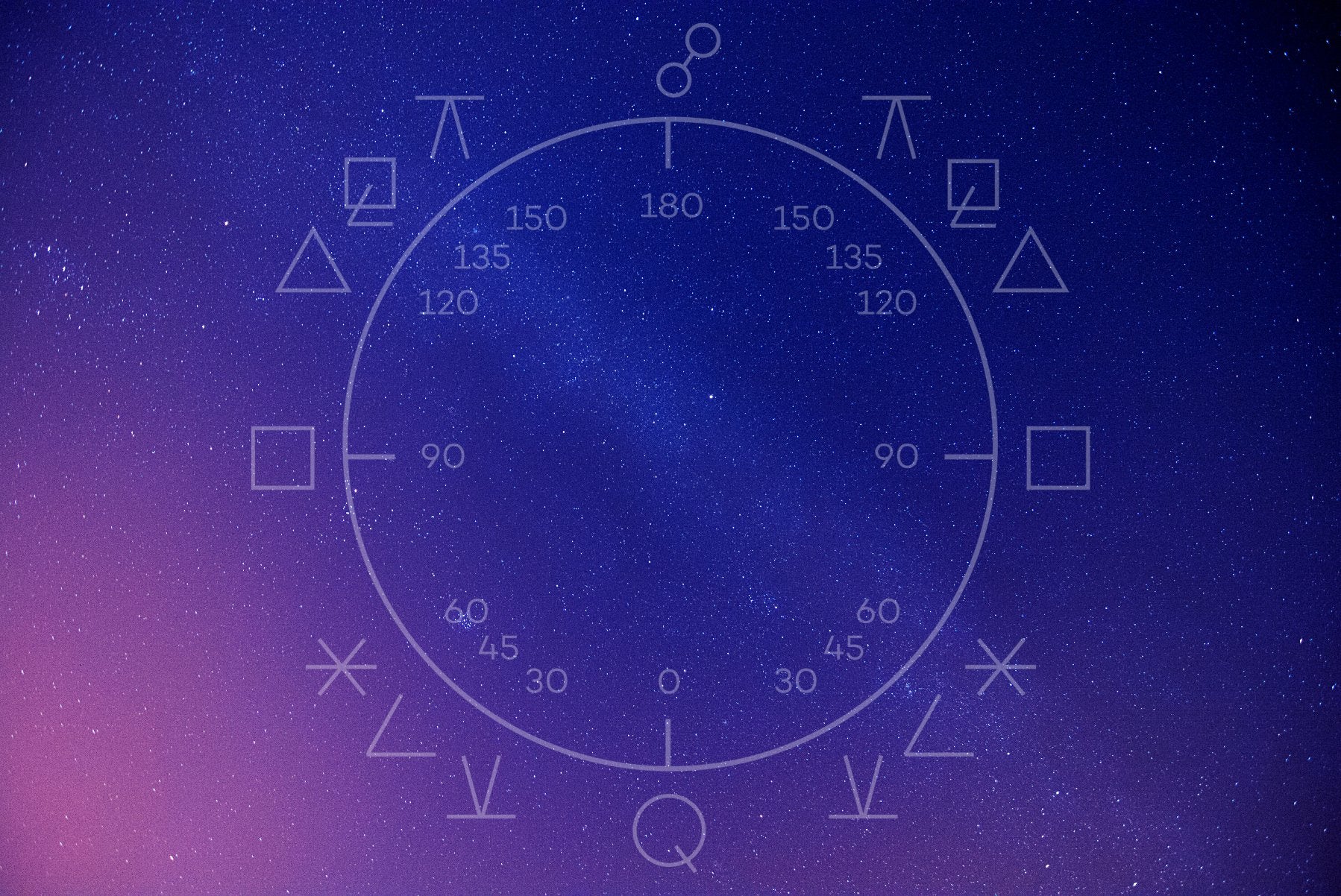Astrology Explained: Planetary Aspects

The planetary aspects describe how the planets act.
So far, we've discussed three of the four foundations in astrology, the planets, the zodiac signs, and the houses. Moving on, let's talk about the fourth and final leg of the table, the planetary aspects.
What are aspects?
The term "aspect" refers to the angle which planets make to each other.
Imagine a massive table at which each planet has a seat. Planets can either sit next to each other, across from each other, or at an angle to each other. Where each planet sits in relation to one another determines how they communicate.
It's arguably more comfortable to have a conversation if someone is sitting next to you nearby, as opposed to sitting all the way across the table or at a weird angle.
While the planets themselves make the angles (and thus the aspects), you also have to consider the signs in which the planets are placed. Not only will the sign add color and depth to the planet's energy, but much can be said about the element and mode of the sign as well.
Think of the sign a planet is in as the type of chair they are sitting on. Some chairs are comfortable, like a La-Z-Boy, while others are uncomfortable, like a chair made of needles.
Calculating aspects takes you back to high school geometry, as they result from mathematical calculations (I'll spare you the boring details). At its simplest explanation, you arrive at the different aspects by diving the circle (360 degrees) by different numbers, and I'll get to the specifics later.
There are eleventh different aspects: the conjunction, the opposition, the trine, the square, the quintile, the bi-quintile, the sextile, the semi-square, the sesquiquadrate, the quincunx, and the semi-sextile.
These aspects are grouped according to their importance in the chart as well as their inherent quality.
Major aspects are arguably more important than minor or lesser used aspects (although this is not necessarily a hard and fast rule).
Concerning the quality of the aspects, some are soft - they can be considered "good," "beneficial," or "easy," - and others are hard - they are considered "not so good," or "challenging."
Why do aspects matter?
Let's go back to the example of the planets sitting around the table.
By examining the type of conversations the planets are having with each other, you can determine the room's general atmosphere.
In the same way, aspects help us determine a particular chart's general atmosphere by giving details about each conversation and connection.
For instance, suppose you are looking at a chart with many trines (major, soft aspect). The general atmosphere of the chart can be considered positive, easygoing, and without challenges or obstacles. Contrast that with a chart that contains many squares (major, hard aspect). That chart can be considered difficult, challenging, and with many obstacles.
Knowing this information is useful because it can show you what areas of your life need work, where you need to exert effort to take advantage of opportunities, where you are likely to be challenged and stretched, where you can chill and go with the flow, and where circumstances beyond your control are likely to occur.
The Major Aspects
The Conjunction

Planets in conjunction are always united.
- Division of the circle by 1
- Degrees apart: 0°
- Signs apart: 0
- Orb: 8
- Major aspect
- Keyword: MIXING
Planets are conjunct when they are at the exact same degree or within eight degrees of each other.
The planets' respective energies are mixed together; conjunctions are about synergy.
Conjunctions are pretty potent and stand in a category by themselves as far as planetary aspects go. The conjunction is often thought of as the most crucial aspect and is not classified as hard or soft.
Think about it. When you blend two or more things together, they are no longer individual entities but rather one new entity made up of individual parts. That's the essence of a conjunction.
Conjunctions often denote a blind spot, as it's hard to determine where one planet begins, and another ends. The planets have difficulty in acknowledging each other as distinct or separate.
Conjunctions involving the Sun are in a class by themselves and fall into three categories: 1) Combust; 2) Under the Sunbeams; and 3) Cazimi.
Planets are known as combust when they come within eight degrees of the Sun. In this placement, the Sun overpowers the planet's influence, causing the planet to be hidden, energetically speaking. A planet is under the sunbeams if it is within 8 and 17 degrees of the Sun, and the planet's influence is weakened, but not as much as if the planet were combust. Finally, a planet is referred to as cazimi if its center is within 17 minutes of the arc of the center of the Sun. Cazimi denotes good fortune and opportunity.
A conjunction involving three or more planets within eight degrees of each other is called a stellium.
The Opposition

Opposite are alike; they only differ in degree.
- Division of the circle by 2
- Degrees apart: 180°
- Signs apart: 6
- Orb: 8
- Type of aspect: Major; Hard
- Keywords: OBJECTIVE, PROJECTION, EXTERNAL DILEMMA
the planets range between 172° and 188°. Planets in opposition are six signs apart.
The planets' respective energies project onto each other; oppositions are about polarity.
Oppositions represent extremes. Think of the concept of light and dark. The thing about extremes, though, is that they complement each other and, in a way, serve to check the other's extremism. In this way, you can view "light" as the absence of "dark" and vice versa.
Elements in opposition are compatible. For example, air signs oppose fire signs (Gemini vs. Sagittarius; Aries vs. Libra; Leo vs. Aquarius). These elements can coexist; air is the one element that can't put our fire, but you can't start a fire without air.
Oppositions come into play, particularly concerning relationships. It follows that the key to overcoming oppositions is moderation, cooperation, and compromise.
The Trine

Trines live on easy street.
- Division of the circle by 3
- Degrees apart: 120°
- Signs apart: 4
- Orb: 8
- Type of aspect: Major; Soft
- Keywords: EQUILIBRIUM; SOOTHES TENSIONS; BODY, MIND, AND SPIRIT
Planets trine each other when they are 120° apart. With an orb of eight degrees, the planets range between 112° and 128°. Planets in trine to one another are four signs apart.
The planets' respective energies reinforce and support each other; trines are about ease and flow.
Of all the soft aspects, trines are THE softest and are considered very beneficial. This is partly because planets in trine share the same element.
Trines represent innate talents and things we enjoy doing.
There's no trying with trines, only being. Inherent in this theory are the notions of healing, acceptance, and recharging.
One of the essential things to remember about trines is that they don't foster growth or evolution, although generally positive. Rather, trines represent the things and behaviors that we fall back on when things in our lives get tough.
The Square

Squares stretch us through strain.
- Division of the circle by 4
- Degrees apart: 90°
- Signs apart: 3
- Orb: 8
- Type of aspect: Major; Hard
- Keywords: TENSION, RESISTANCE, INTERNAL DILEMMA
Planets square each other when they are 90° apart. With an orb of eight degrees, the planets range between 82° and 98°. Planets square to one another are three signs apart.
The planets' respective energies are tense and incompatible; squares are about tension and strain.
Mathematically speaking, squares are one-half of oppositions, and the two aspects get compared a lot. There are some significant differences, however.
First, squares occur between incompatible elements. For example, Capricorn, as an earth sign, is square to Libra, an air sign.
To put it another way, while oppositions represent different sides of the same coin, squares represent two different coins.
Planets square to each other want different things and work at cross purposes; they get in each other's way.
In a chart, squares can denote areas where we experience fear, doubt, and uncertainty.
Squares often represent obstacles and struggles; however, squares stretch us and help us grow and develop. When thinking of squares, remember, "rough seas make the best sailors."
The Sextile

Sextiles coax and cooperate.
- Division of the circle by 6
- Degrees apart: 60°
- Signs apart: 2
- Orb: 4
- Type of aspect: Major; Soft
- Keywords: LATENT TALENTS, AWARENESS, ASSISTANCE
Planets form a sextile aspect when they are 60° apart. With an orb of four degrees, the planets range between 56° and 64°. Planets sextile to one another are two signs apart.
The planets' respective energies coax and cooperate; sextiles are about opportunity.
Sextiles often get grouped with trines, as both aspects are soft and denote positive energy flow. Whereas trines are about allowing and letting things flow, sextiles require a slight bit of effort.
Sextiles occur between different but compatible elements and represent hidden talents and abilities. Sextiles coax us into bringing those talents to the surface, and doing so can bring about harmony and positivity.
The number six is associated with the planet Venus and gives the sextile Venusian qualities such as pleasure, harmony, enjoyment, attraction, and value.
The Minor Aspects
The Semi-Square

Semi-squares force a release.
- Division of the circle by 8
- Degrees apart: 45°
- Orb: 2
- Type of aspect: Minor; Hard
- Keywords: DIFFICULT, UNSTABLE, PERSISTING
Planets form a semi-square aspect when they are 45° apart. With an orb of two degrees, the planets range between 43° and 45°.
The planets' respective energies are difficult and unstable; semi-squares accelerate events.
Semi-squares, along with sesquiquadrates, share many similarities to squares. The only significant difference between the semi-square and square is that the former does not have the same energy of uncertainty and hesitation.
Semi-squares are very much concerned with external circumstances. Even though it's considered a challenging aspect, it can work out favorably, depending on the situation.
The Sesquiquadrate

Sesquiquadrates compel and challenge.
- Division of the circle by 8
- Degrees apart: 135°
- Orb: 2
- Type of aspect: Minor; Hard
- Keywords: TENSION, COMPELLED, CHALLENGES
Planets in sesquiquadrate are 135° apart. With an orb of two degrees, the planets range between 133° and 137°.
The planets' respective energies are tense and challenging; sesquiquadrates also accelerate events.
Semi-squares, along with sesquiquadrates, share many similarities to squares. The only significant difference between the semi-square and square is that the former does not have the same energy of uncertainty and hesitation.
Semi-squares are very much concerned with external circumstances. Even though it's considered a challenging aspect, it can work out favorably, depending on the situation.
The Quincunx

Quincunxes have you stuck between a rock and a hard place.
- Division of the circle by multiples of 12
- Degrees apart: 150°
- Signs apart: 5
- Orb: 2
- Type of aspect: Minor; Hard
- Keywords: AWKWARD, ADJUSTMENT, UNSUPPORTIVE
Planets in quincunx are 150° apart. With an orb of two degrees, the planets range between 148° and 152°. Planets in quincunx are five signs apart.
The planets' respective energies are awkward and unsupportive; quincunxes are about friction.
The quincunx (also known as the inconjunct) is about integrating two completely different energies that seem to have nothing to do with each other. Signs in quincunx share neither mode nor element. As such, quincunxes require a certain level of adjustment.
Quincunxes denote some sort of additional stress and irritation. It is through this irritation that we either bend or break.
The Semi-Sextile

Semi-sextiles are neighbors.
- Division of the circle by multiples of 12
- Degrees apart: 30°
- Signs apart: 1
- Orb: 2
- Type of aspect: Minor
- Keywords: IGNORES, REDIRECTS, UNSETTLING
Planets form a semi-sextile aspect when they are 30° apart. With an orb of two degrees, the planets range between 28° and 32°. Planets in semi-sextile are one sign apart.
Planets in semi-sextile are neighbors, and as we all know, neighbors sometimes don't get along. Other times, neighbors ignore each other and just go about their business.
Semi-sextiles often support and confirm other information in the chart and are examined on a very individualistic basis. To determine the strength or effect, you need to look at the individual planets involved.
Semi-sextile can be soft aspects if you are open to opportunities.
The Lesser Used Aspects
The Quintile

The quintile is hands-on.
- Division of the circle by 5
- Degrees apart: 72°
- Orb: 2
- Type of aspect: Lesser Used
- Keywords: CREATIVE, EVOLUTIONARY POTENTIAL, ARRANGING AND MAKING
Planets in quintile are 72° apart. With an orb of two degrees, the planets range between 70° and 74°.
As with the other minor aspects, there isn't a cookie-cutter definition for the quintile. Instead, the interpretation of this aspect is made on a very individualized and specific basis.
However, what can be said about the quintile is that its interpretation lies in the numerology of the number five.
The number five is associated with harvesting, specifically related to the arrangement of what's been harvested. The number five, in a way, is about giving form to things, creating them. It follows that we can associate quintiles with arranging, making, and giving shape to various things.
The best way to remember the quintile is that your hands have five fingers, which you can use to arrange and make things.
Inherent in the quintile is the notion of an individual's personal style. This notion lends itself to creativity, as well as the potential to create.
The Bi-Quintile

The bi-quintile is hands-on.
- Division of the circle by 5
- Degrees apart: 144°
- Orb: 2
- Type of aspect" Lesser Used
- Keywords: CREATIVE, EVOLUTIONARY POTENTIAL, ARRANGING AND MAKING
Planets in bi-quintile are 144° apart. With an orb of two degrees, the planets range between 142° and 146°.
The bi-quintile is a part of the quintile series, as both aspects require a division of the circle by five.
As with the other minor aspects, there isn't a cookie-cutter definition for the quintile. Instead, the interpretation of this aspect is made on a very individualized and specific basis.
However, what can be said about the quintile is that its interpretation lies in the numerology of the number five.
The number five is associated with harvesting, specifically related to the arrangement of what's been harvested. The number five, in a way, is about giving form to things, and creating them. It follows that we can associate quintiles with arranging, making, and giving shape to various things.
The best way to remember the quintile is that your hands have five fingers, which you can use to arrange and make things.
Inherent in the quintile is the notion of an individual's personal style. This notion lends itself to creativity, as well as the potential to create.




Comments